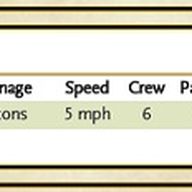Cost: This is the cost to purchase the ship outright, assuming one has the appropriate paperwork and licences for the area it is being sold in. Black market modifiers are ultimately at the DM's discretion.
Built by: The origin of the vehicle, expressed as a race or nation of origin, can provide inspiration into the description and behaviour of a ship, as well as influence the attitudes of NPCs and PCs alike as they interact with it.
Tonnage: The weight of the vessel in tons. This figure can be useful in situations where the weight or mass might be of some relevance, especially if the vessel must be pulled by draft animals.
Speed: To convert a ship's overland speed to feet per round, simply multiply the speed by 10. While this might not be the most accurate method, it is the most convenient.
Crew: The minimum number of crew required for the ship to function without penalty. The speed of a vehicle with less than 90% of its crew is reduced by 1 mph. A vehicle with less than half its crew cannot take any manner of attack actions or reactions, and a ship with less than a quarter of its crew is slowed, and has disadvantage on all ability checks.
See page 119 of the DMG for more details.
Passengers: Unless otherwise noted, the passengers figure represents the number of small or medium creatures the ship can carry at a poor accommodation.
Cargo (tons): This represents the amount of cargo a ship can hold without penalty. Typically this number is larger on sailing vessels than on land or air vehicles of similar size.
A vessel which exceeds this limit is reduced to half speed, and a vessel which carries cargo in excess of its limit will be unable to set a speed and will react differently depending on its vehicular type.
Land vehicles will require repairs equal to 1/4 of their hit points in order to move again, as the weight has damaged their chassis.
Water vehicles will sink at a rate of 5ft per round. They are assumed to have a deck elevation equal to 1/4 of their beam width.
Air vehicles will descend at a rate of 60ft per round.
Damage Threshold: Any effect which deals damage to the ship must meet or exceed this threshold. Attacks which fall short of this threshold have no effect. Those attacks which exceed this threshold deal damage as normal.
Hitpoints: A vessel's hit points decrease when it takes damage greater than its damage threshold. Damage typically doesn't have any impact on a vessel's functions until its current hit points reach 0 or lower.
Landing: Some airships are limited in the areas on which they may moor. Some airships can land without assistance on solid ground, others are designed to land on bodies of water.
Airships without the capacity to land may only do so at purpose-built structures, or airship docks. Otherwise, they must anchor above the ground.
Vehicles which attempt to land on solid ground without the ability to do so take damage equal to 1d10 times their current speed (in mph) divided by 10, to a minimum of 1d10.
Vehicles which attempt to land on water without the ability to do so will sink at a rate of 5ft per round. After one round, their speed is slowed, and after two rounds, their speed is 0 until removed from the water.
Keel: This represents the total length of the ship, excluding any sails, air-balloons, or attached bladders.
Beam: This represents the total width of the ship, excluding any sails, air-balloons, or attached bladders.
Weapons: The number of weapon slots on a ship is an abstraction of the number of weapon systems which could be installed on a ship without extensive modification.
